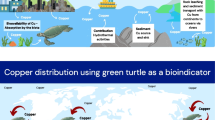Abstract
Trace metals (Cd, Cu, Pb, Zn) were measured in mixed zooplankton samples collected from the open water of Lake Balaton (Hungary) in order to assess spatial and seasonal changes in the heavy metal load of different sites, during 1996–2000.Samplings were performed usually twice a year in different seasons (spring, summer and autumn). The heavy metal concentrations of zooplankton biomass were determined by atomic absorption spectrophotometry. Additionally, for some of the sampling sites – Western- and Eastern basins – the correlations between the heavy metal load of Crustaceans and the element concentrations of the water recorded monthly by the Transdanubian Environmental Protection Agency were also analyzed.The average metal concentrations in zooplankton varied in the following ranges: Cd: 0.25 – 3.91; Cu: 5.9 – 26.4; Pb: 1.59 – 12.84; Zn: 37.6 – 180.5 mg kg−1 dry weight. Significant spatial and seasonal variations with occasionally outstanding differences in the heavy metal load of samples could be observed during the investigated period. The heavy metal load of the Crustacea plankton biomass in summer and autumn proved to be usually higher than in spring. During the investigated period an overall significant increase in the cadmium, copper and lead load of the Crustacea plankton populating the lake could be observed. Pearson correlation analysis performed between the heavy metal concentration of Crustacea plankton biomass and that of the water in the two outlying basins of the lake revealed strong relationship for Cd, Cu and Zn, while for lead the correlation proved to be not significant.
Similar content being viewed by others
References
Chen, C. Y, R. S. Stemberger, B. Klaue, J. D. Blum, P. C. Pickhardt & C. L. Folt, 2000. Accumulation of heavy metals in food web components across a gradient of lakes. Limnol. Oceanogr. 45: 1525–1536.
Czégény, I., I. Dévai & Gy. Dévai, 1984. Heavy metal analyses. In Dévai, Gy. (ed.), Studies of the Ecological Effects of Lake Balaton and River Zala Sediments on Chironomids (Diptera: Chironomidae). Acta Biologica Debrecina Oecologia Hungarica, Supplementum Oecologia Hungarica 1: 131–133.
Farkas, A., 1993. Preparation of samples for heavy metal analyses and measuring heavy metals. In Salánki, J. & V. Istvánovics (eds), Limnological Bases of Lake Management. Proceedings of the ILEC/UNEP International Training Course 24May – 5 June 1993 Tihany Hungary. ILEC Kusatsu Shiga Japan: 160–163.
Hellawell, J. M., 1986. Biological indicators of freshwater pollution and environmental management. Elsevier Amsterdam: 546–554.
Herodek, S., V. Istvánovics, G. Jolánkai, P. Csathó, T. Németh & Gy. Várallyay, 1995. P-cycle in the Balaton catchment – a Hungarian case study. In Thiessen, H. (ed.), Phosphorus in the Global Environment. John Wily & Sons Ltd.: 275–300.
Hlavay, J., K. Polyák, Á. Molnár & E. Mészáros, 1999. Development of a monitoring network for the analysis of elements in aerosol samples collected at Lake Balaton. Acta Biol. Hun. 50: 89–98.
Krishnamurty, K. V., E. E. Shprit & M. M. Reddy, 1976. Trace metal extraction of soils and sediments by nitric acid-hydrogen peroxide. Atom. Absorp. Newsl. 15: 68–70.
Merian, E. (ed.), 1991. Metals and their Compounds in the Environment. VCH, Weinheim.
Müller, G., 1981. Heavy metals and nutrients in sediments of Lake Balaton, Hungary. Environmental Technology Letters 2: 39–48.
Parpal?, L., L.G.-Tóth, V. Zinevici, P. Németh & K. Szalontai, 2003. Structure and production of metazoan zooplankton in Lake Balaton (Hungary) in summer. Hydrobiologia 506–509: ???
Phillips, D. J. H., 1980. Quantitative aquatic biological indicators. Applied Science Publishers, London: 488–493.
Ponyi, J., 1975. The biomass of zooplankton in Lake Balaton. Symposia Biologica Hungarica 15: 215–224.
Ponyi, J., 1991. Feeding, population dynamics and production of aquatic invertebrates in Lake Balaton, with particular attention to the role of biotic factors. In Lázár, G. (ed.), Advances in Biological Research in Hungary: 1986–1990. Ecology, Bp., AKAPRINT: 58–61.
Prosi, F., 1981. Heavy Metals in Aquatic Organisms. In Förstner, U. & G. T. W. Wittmann (eds), Metal Pollution in the Aquatic Environment. Springer-Verlag Berlin.
Ritterhoff, J. & G. P. Zauke, 1997. Trace metals in field samples of zooplankton from the Fram Strait and the Greenland Sea. Sci. Total Environ. 199: 255–270.
Stemberger, R. S. & C. Y. Chen, 1998. Fish tissue and zooplankton assemblages of Northeastern U.S. lakes. Can. J. Fish. Aquat. Sci. 55: 339–352.
Salánki, J., K. V.-Balogh & E. Berta, 1982. Heavy metals in animals of Lake Balaton. Wat. Res. 16: 1147–1152.
V.-Balogh, K., L. Vörös, N. Tóth & M. Bokros, 2003. Changes of organic matter quality along the longitudinal axis of a large shallow lake (Lake Balaton). Hydrobiologia 506–509: 67–74.
Zánkai, P. N. & J. E. Ponyi, 1986. Composition, density and feeding of crustacean zooplankton community in a shallow, temperate lake (Lake Balaton, Hungary). Hydrobiologia 135: 131–147.
Author information
Authors and Affiliations
Rights and permissions
About this article
Cite this article
Farkas, A., Salánki, J. & Varanka, I. Crustaceans as biological indicators of heavy metal pollution in Lake Balaton (Hungary). Hydrobiologia 506, 359–364 (2003). https://doi.org/10.1023/B:HYDR.0000008615.86330.1d
Issue Date:
DOI: https://doi.org/10.1023/B:HYDR.0000008615.86330.1d




